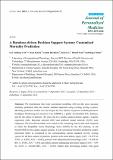| dc.contributor.author | Celi, Leo Anthony G. | |
| dc.contributor.author | Galvin, Sean | |
| dc.contributor.author | Davidzon, Guido | |
| dc.contributor.author | Lee, Joon | |
| dc.contributor.author | Scott, Daniel | |
| dc.contributor.author | Mark, Roger Greenwood | |
| dc.date.accessioned | 2013-03-12T18:03:24Z | |
| dc.date.available | 2013-03-12T18:03:24Z | |
| dc.date.issued | 2012-09 | |
| dc.date.submitted | 2012-09 | |
| dc.identifier.issn | 2075-4426 | |
| dc.identifier.uri | http://hdl.handle.net/1721.1/77628 | |
| dc.description.abstract | We hypothesize that local customized modeling will provide more accurate mortality prediction than the current standard approach using existing scoring systems. Mortality prediction models were developed for two subsets of patients in Multi-parameter Intelligent Monitoring for Intensive Care (MIMIC), a public de-identified ICU database, and for the subset of patients >80 years old in a cardiac surgical patient registry. Logistic regression (LR), Bayesian network (BN) and artificial neural network (ANN) were employed. The best-fitted models were tested on the remaining unseen data and compared to either the Simplified Acute Physiology Score (SAPS) for the ICU patients, or the EuroSCORE for the cardiac surgery patients. Local customized mortality prediction models performed better as compared to the corresponding current standard severity scoring system for all three subsets of patients: patients with acute kidney injury (AUC = 0.875 for ANN, vs. SAPS, AUC = 0.642), patients with subarachnoid hemorrhage (AUC = 0.958 for BN, vs. SAPS, AUC = 0.84), and elderly patients undergoing open heart surgery (AUC = 0.94 for ANN, vs. EuroSCORE, AUC = 0.648). Rather than developing models with good external validity by including a heterogeneous patient population, an alternative approach would be to build models for specific patient subsets using one’s local database. | en_US |
| dc.description.sponsorship | National Institutes of Health (U.S.) (National Institute of Biomedical Imaging and Bioengineering (U.S.)) (Grant R01 EB001659) | en_US |
| dc.language.iso | en_US | |
| dc.publisher | MDPI AG | en_US |
| dc.relation.isversionof | http://dx.doi.org/10.3390/jpm2040138 | en_US |
| dc.rights | Article is made available in accordance with the publisher's policy and may be subject to US copyright law. Please refer to the publisher's site for terms of use. | en_US |
| dc.source | MDPI | en_US |
| dc.title | A Database-driven decision support system: customized mortality prediction | en_US |
| dc.type | Article | en_US |
| dc.identifier.citation | Celi, Leo Anthony et al. “A Database-driven Decision Support System: Customized Mortality Prediction.” Journal of Personalized Medicine 2.4 (2012): 138–148. © 2012 MDPI AG | en_US |
| dc.contributor.department | Massachusetts Institute of Technology. Institute for Medical Engineering & Science | en_US |
| dc.contributor.department | Harvard University--MIT Division of Health Sciences and Technology | en_US |
| dc.contributor.mitauthor | Celi, Leo Anthony G. | |
| dc.contributor.mitauthor | Lee, Joon | |
| dc.contributor.mitauthor | Scott, Daniel | |
| dc.contributor.mitauthor | Mark, Roger Greenwood | |
| dc.relation.journal | Journal of Personalized Medicine | en_US |
| dc.eprint.version | Final published version | en_US |
| dc.type.uri | http://purl.org/eprint/type/JournalArticle | en_US |
| eprint.status | http://purl.org/eprint/status/PeerReviewed | en_US |
| dspace.orderedauthors | Celi, Leo Anthony; Galvin, Sean; Davidzon, Guido; Lee, Joon; Scott, Daniel; Mark, Roger | en |
| dc.identifier.orcid | https://orcid.org/0000-0001-8593-9321 | |
| dc.identifier.orcid | https://orcid.org/0000-0002-6318-2978 | |
| dspace.mitauthor.error | true | |
| mit.license | MIT_AMENDMENT | en_US |
| mit.metadata.status | Complete | |
